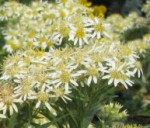 Flat topped white aster, also known as parasol whitetop and tall white aster, is a bushyherbaceous perennial native to eastern and north central US where it is found in moist to wet slightly acidic soils in meadows, fields, thickets, seeps, and swamp borders. It is a member of the Asteraceae family that also includes daisies, sunflowers, yarrow, and lettuce. The wiry stems branch only at the top, lack basal foliage, but have lanceolate to elliptical leaves from three to six inches long along their length. The ½-3/4 inch flowerheads appear in late summer to fall and are carried in somewhat flat clusters. Each flowerhead is up to ten inches across and consists of ten to fifteen downcurving ray flowers that are white tinged with purple and surround a center of yellow disk flowers that turn gray with age. The flowers provide nectar and pollen for a variety of insects including bees and butterflies and the foliage provide food for larval butterflies and moths. The seeds provide food for birds. A good choice for wildflower, wet meadow, butterfly and rain gardens. The generic name Aster comes from the Latin word aster meaning star and refers to the form of the flowers. The specific epithet umbellatus refers to the inflorescence that is characterized by the fact that all the flowering stalks arise from the same place.
Flat topped white aster, also known as parasol whitetop and tall white aster, is a bushyherbaceous perennial native to eastern and north central US where it is found in moist to wet slightly acidic soils in meadows, fields, thickets, seeps, and swamp borders. It is a member of the Asteraceae family that also includes daisies, sunflowers, yarrow, and lettuce. The wiry stems branch only at the top, lack basal foliage, but have lanceolate to elliptical leaves from three to six inches long along their length. The ½-3/4 inch flowerheads appear in late summer to fall and are carried in somewhat flat clusters. Each flowerhead is up to ten inches across and consists of ten to fifteen downcurving ray flowers that are white tinged with purple and surround a center of yellow disk flowers that turn gray with age. The flowers provide nectar and pollen for a variety of insects including bees and butterflies and the foliage provide food for larval butterflies and moths. The seeds provide food for birds. A good choice for wildflower, wet meadow, butterfly and rain gardens. The generic name Aster comes from the Latin word aster meaning star and refers to the form of the flowers. The specific epithet umbellatus refers to the inflorescence that is characterized by the fact that all the flowering stalks arise from the same place.
Type: Herbaceous perennial
Bloom: Ten inch flat topped clusters of flowerheads consisteing of ten to fifteen downcurving white ray flowers tinged with purple and surround a center of yellow disk flowers; in late summer to fall
Size: 2-7’ H x 2-4’ W
Light: Full sun to partial shade
Soil: Average, medium moist to moist, well-drained, slightly acidic
Hardiness: Zones 3-8
Care: Cut back plants after flowering or in spring before new growth appears.
Pests and Diseases: None of significance
Propagation: Division, seed
Companion Plants: Goldenrod, Joe Pyeweed, black eyed Susan, sneezewort, wild golden glow, cardinal flowers (Lobelia cardinalis), swamp milkweed